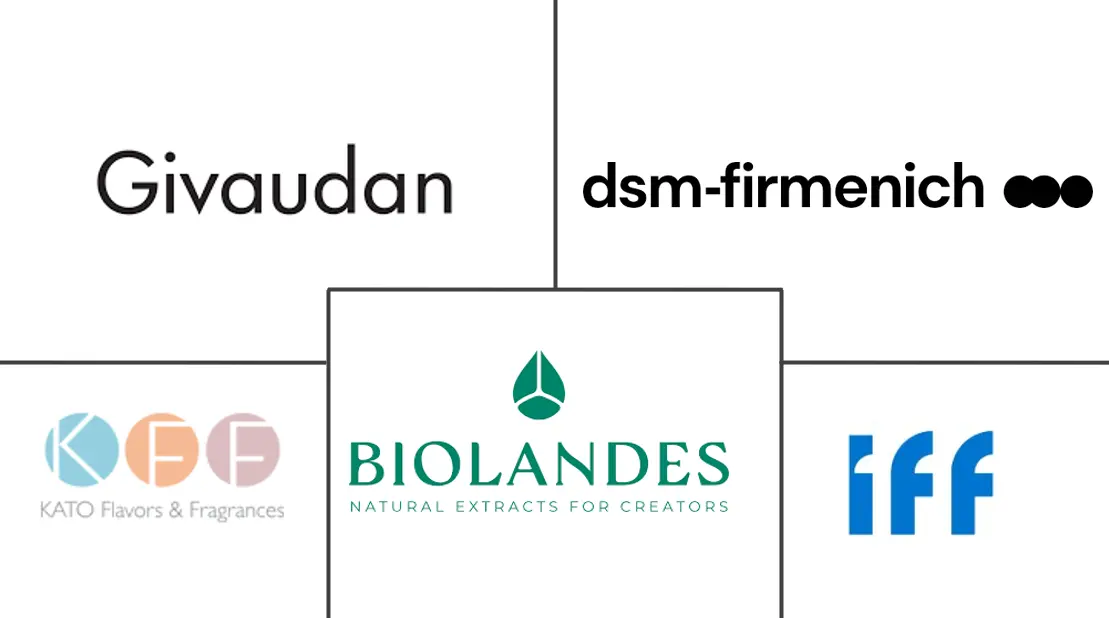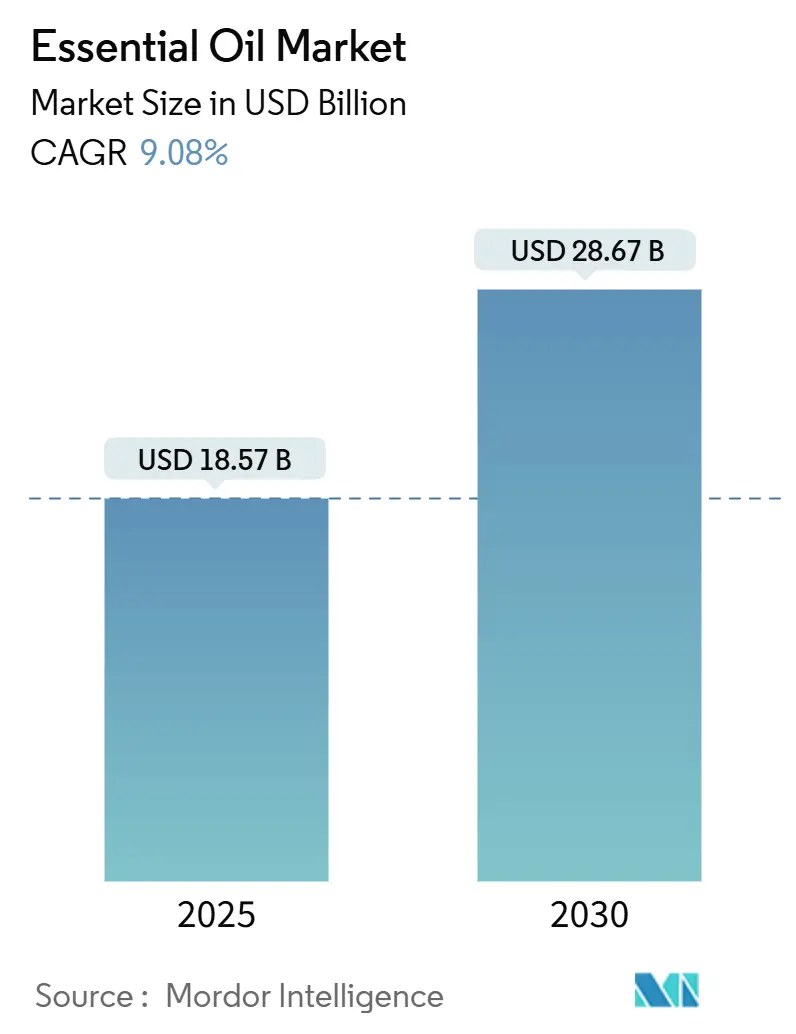
Essential Oil Market Analysis by Mordor Intelligence
The essential oils market is estimated to be valued at USD 18.57 billion in 2025 and is projected to reach USD 28.67 billion by 2030, expanding at a CAGR of 9.08%. This growth trajectory reflects the convergence of therapeutic validation, technological extraction advances, and shifting consumer preferences toward natural alternatives across multiple industries. The FDA's expanded recognition of essential oils under Generally Recognized as Safe (GRAS) status for food applications has unlocked new revenue streams, while regulatory frameworks in Europe continue to tighten around synthetic alternatives FDA [1]U.S. Food and Drug Administration, “GRAS Notices Inventory,” fda.gov. Climate-related pressures on citrus production and concerns about synthetic aroma compounds have led companies to diversify their procurement sources and created premium pricing opportunities for certified-organic oils. Companies are implementing supply chain resilience strategies, including precision irrigation for drought-tolerant botanicals and relocating production to regions less affected by climate change. Additionally, the adoption of supercritical CO₂ and microwave-assisted extraction technologies has reduced processing times and improved yields.
Key Report Takeaways
- By type, citrus oils led with 24.65% revenue share in 2024; eucalyptus oil is projected to expand at an 11.36% CAGR through 2030.
- By source, fruits and vegetables held 38.15% of the essential oils market share in 2024, while herbs and spices are forecast to grow at a 12.21% CAGR to 2030.
- By nature, conventional oils accounted for 65.12% of the essential oils market size in 2024; organic or certified-organic oils are advancing at a 13.15% CAGR to 2030.
- By application, food and beverages commanded 42.15% of the essential oils market size in 2024; aromatherapy and wellness is rising at a 12.54% CAGR through 2030.
- By geography, Europe captured 39.19% revenue share in 2024; Asia-Pacific is on track for the fastest expansion at an 11.65% CAGR to 2030.
Global Essential Oil Market Trends and Insights
Driver Impact Analysis
| Driver | (~) % Impact on CAGR Forecast | Geographic Relevance | Impact Timeline |
|---|---|---|---|
| Rising demand in therapeutic applications | +2.1% | Global, with concentration in North America & Europe | Medium term (2-4 years) |
| Increasing popularity of natural fragrances in perfumes and personal care products | +1.8% | Europe & North America, expanding to Asia-Pacific | Long term (≥ 4 years) |
| Adoption of natural flavorings and additives in food and beverages | +1.5% | Global, led by North America & EU regulatory frameworks | Short term (≤ 2 years) |
| Growing demand for essential oils in household and industrial cleaning solutions | +1.2% | North America & Europe, emerging in Asia-Pacific | Medium term (2-4 years) |
| Expanding application of essential oils in eco-friendly packaging and material innovation | +0.9% | Europe & North America, pilot programs in Asia-Pacific | Long term (≥ 4 years) |
| Technological advancements in extraction and production | +1.3% | Global, with early adoption in developed markets | Short term (≤ 2 years) |
| Source: Mordor Intelligence | |||
Rising Demand in Therapeutic Applications
Recent clinical studies demonstrate that eucalyptus, tea tree, and clove oils possess significant antimicrobial, anti-inflammatory, and pain-relieving properties comparable to traditional medications, prompting hospitals to incorporate them into their standard formularies. The FDA's expansion of Generally Recognized as Safe status has streamlined regulatory approval processes for both oral and topical pharmaceutical applications. The pharmaceutical-grade essential oils command premium prices, selling at 3-4 times higher than their cosmetic-grade counterparts, which substantially increases profit margins across the supply chain. Healthcare providers are increasingly integrating specific oil chemotypes into customized treatment protocols, creating stronger provider-patient relationships and improving treatment adherence. To meet growing demand, contract manufacturers are establishing specialized clean-room distillation facilities that comply with Good Manufacturing Practice requirements, ensuring consistent supply for clinical trials and pharmaceutical applications.
Increasing Popularity of Natural Fragrances in Perfumes and Personal Care Products
The increasing consumer rejection of synthetic fragrance compounds is fundamentally transforming formulation strategies in the personal care industry. The EU's enhanced allergen disclosure requirements for synthetic fragrances are creating significant market advantages for natural essential oil formulations, particularly in premium segments where consumers prioritize clean and transparent ingredients[2]CBI,"European Market for Essential Oils",www.cbi.eu. In 2024, Estée Lauder Companies made a strategic investment in Exuud, aiming to incorporate Exuud's patented Soliqaire fragrance delivery system into its portfolio by the close of 2025, bolstering its luxury fragrance innovations. Young Living's establishment of Wyld Notes, a sister company offering 100% natural fine fragrances, indicates direct-to-consumer brands are gaining substantial market share from traditional fragrance houses.
Adoption of Natural Flavorings and Additives in Food and Beverages
The food industry uses essential oils as natural flavorings to meet clean label requirements and regulations on synthetic additives. European food manufacturers are reformulating products by replacing artificial flavors with essential oils to meet consumer demand for natural ingredients. Essential oils provide both flavor enhancement and preservation benefits, allowing manufacturers to reduce their overall additive usage. The preservation properties, including antimicrobial and antioxidant effects, help extend product shelf life naturally. These natural compounds have demonstrated significant potential in food preservation, making them valuable alternatives to synthetic preservatives. However, supply chain disruptions from climate factors create price volatility in the essential oils market, sometimes making synthetic alternatives more cost-effective for certain food applications.
Growing Demand for Essential Oils in Household and Industrial Cleaning Solutions
Environmental regulations on synthetic cleaning chemicals have accelerated the adoption of essential oil-based formulations across consumer and industrial applications. Essential oils, particularly tea tree and eucalyptus, deliver powerful antimicrobial properties beyond fragrance, enabling manufacturers to significantly reduce or eliminate synthetic preservatives and antimicrobial agents in their formulations. Extensive laboratory studies and field trials demonstrate that essential oil nanoemulsions consistently match or exceed the antimicrobial effectiveness of conventional preservatives while fully complying with clean label standards and sustainability requirements. The industrial cleaning segment presents substantial growth potential, as essential oils function as highly effective, biodegradable substitutes for petroleum-based solvents in applications ranging from surface disinfection to equipment maintenance.
Restraints Impact Analysis
| Restraint | (~) % Impact on CAGR Forecast | Geographic Relevance | Impact Timeline |
|---|---|---|---|
| Climate-driven crop yield volatility and price spikes | -1.9% | Global, particularly Mediterranean & subtropical regions | Short term (≤ 2 years) |
| Increasing competition from synthetic alternatives and fragrance compounds | -1.4% | Global, with higher impact in price-sensitive segments | Medium term (2-4 years) |
| Safety risks in food and pharmaceutical applications | -0.8% | Global, with stricter enforcement in developed markets | Long term (≥ 4 years) |
| Complex regulatory compliance across regions | -1.1% | Global, with highest complexity in EU & North America | Medium term (2-4 years) |
| Source: Mordor Intelligence | |||
Climate-Driven Crop Yield Volatility and Price Spikes
Climate change is disrupting essential oil supply chains, making crop yields increasingly unpredictable due to extreme weather events and shifting growing conditions. The citrus essential oil segment demonstrates this vulnerability, with Florida's orange industry experiencing significant declines since the onset of citrus greening disease, while Brazilian citrus regions report temperature increases affecting oil quality. Studies show that drought stress can increase essential oil yields in certain species, but this requires precise water management capabilities that many producers lack. Mediterranean lavender production experiences substantial yield variations year-over-year due to irregular precipitation patterns, compelling buyers to maintain larger inventory buffers and increase working capital. The market faces significant price instability, with essential oils experiencing substantial price fluctuations within single growing seasons, complicating long-term supply contract negotiations.
Increasing Competition from Synthetic Alternatives and Fragrance Compounds
Synthetic fragrance and flavor compounds provide consistent quality and pricing compared to natural essential oils, which face supply chain disruptions. Advanced synthetic biology techniques enable the production of nature-identical compounds that match essential oil profiles while reducing agricultural supply chain risks. During supply shortages, synthetic alternatives cost significantly less than natural essential oils, prompting reformulation in cost-sensitive applications. However, EU regulations require stricter disclosure of synthetic fragrances, creating advantages for essential oil formulations. Market research indicates that premium segments continue to prefer natural ingredients despite higher prices, demonstrating a clear market division between cost-sensitive and premium applications. Essential oil producers must maintain a reliable and consistent supply to prevent customer migration to synthetic alternatives during periods of shortage, particularly as synthetic technologies continue to advance and offer improved cost efficiencies.
Segment Analysis
By Type: Citrus Oils Dominate Volume While Therapeutic Grades Accelerate
Orange oil dominated the essential oils market in 2024 with a 24.65% share, driven by its extensive applications across beverages, confectionery, and cleaning products. The market value for orange oil reached USD 4.6 billion in 2024 and is projected to grow at a CAGR of 8.9%. This growth persists despite reduced production in Florida, which has led manufacturers to increase sourcing from Brazil and Mediterranean regions. The abundant availability of citrus peels, a by-product of juice processing industries, continues to provide significant cost advantages compared to synthetic alternatives. The growing consumer preference for natural ingredients in food and beverages further strengthens orange oil's market position.
Eucalyptus oil demonstrates strong market potential, supported by scientifically proven antimicrobial properties, and is expected to grow at a CAGR of 11.36%. This growth is primarily driven by increasing demand in pharmaceutical applications, particularly in sinus and respiratory treatments. The mint derivatives segment, including cornmint and spearmint, maintains a robust supply chain primarily centered in India. The country's export volumes have shown remarkable growth, indicating substantial production capacity and scalability potential. The rising adoption of mint derivatives in oral care products, aromatherapy, and traditional medicine applications further supports market expansion.
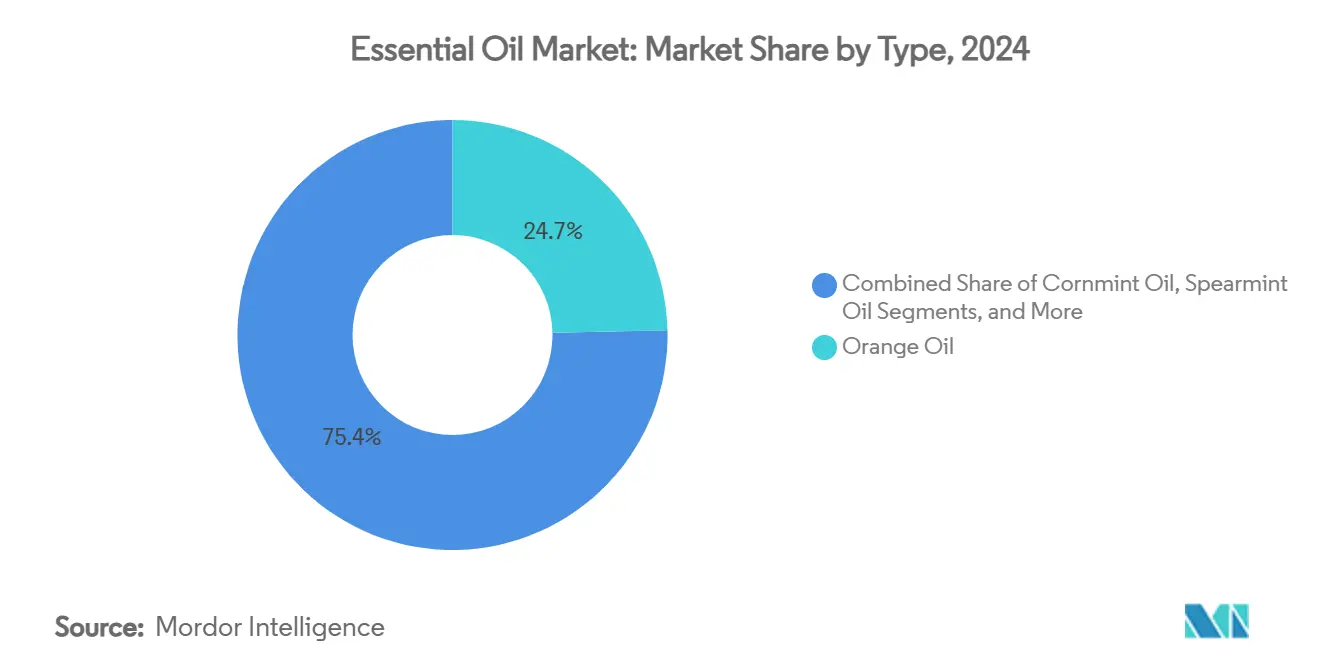
Note: Segment shares of all individual segments available upon report purchase
By Nature: Certification Unlocks Premium Pricing
Conventional production accounts for 65.12% share of revenue in 2024, primarily due to household-cleaning formulators prioritizing cost efficiency and supply reliability. The organic and certified-organic oils segment is expected to grow at a 13.15% CAGR, driven by increased retailer focus on sustainability compliance. While certification increases production costs by 20-40%, German and French importers accommodate these additional expenses to meet consumer demand for chemical-free ingredients. The implementation of blockchain traceability has become a standard practice, facilitating due diligence compliance for premium brands.
EU regulatory requirements for residue limits compel conventional suppliers to adopt reduced-input farming methods to prevent shipment rejections. Organic producers face production challenges due to limited crop protection options. However, organic certification continues to command premium prices in wellness and dermo-cosmetic applications, despite yield fluctuations. The three-to-five-year transition period for new organic producers helps maintain market equilibrium by limiting supply increases and supporting price stability for existing certified producers.
By Source: Waste Streams Confer Cost Leadership
Fruits and vegetables hold a 38.15% market share in 2024, as food processing waste streams provide an economical source for essential oil production. The herbs and spices segment is projected to expand at a 12.21% CAGR through 2030, driven by increasing therapeutic applications. Citrus processing yields significant essential oil volumes as byproducts, with orange peel oil extraction creating additional revenue streams for juice producers. This integrated approach provides cost benefits that dedicated essential oil crops cannot achieve, especially during periods of elevated agricultural input costs.
The herbs and spices segment faces distinct challenges, as many therapeutic oils require dedicated cultivation instead of waste stream extraction. The production of lavender, rosemary, and sage demands specific climate conditions and precise harvest timing to maximize essential oil yields and quality. Research indicates that controlled drought conditions can enhance essential oil yields in herbs such as thyme, though this requires precise irrigation management. The cultivation of these specialty crops necessitates extensive agricultural expertise and careful monitoring throughout the growing season to ensure optimal oil content and composition.
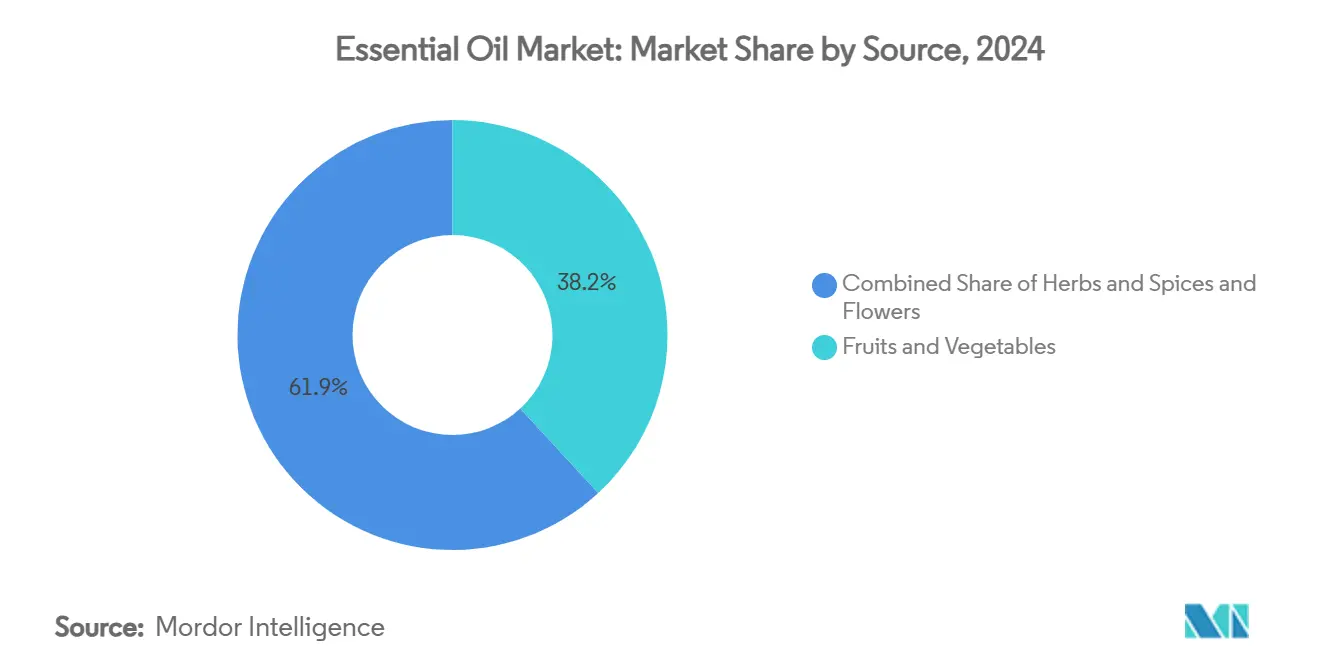
Note: Segment shares of all individual segments available upon report purchase
By Application: Clean-Label Imperatives Drive Adoption
The food and beverage sector accounted for 42.15% of essential oil sales in 2024, driven by bakeries, confectionery manufacturers, and dairy processors replacing synthetic flavors with natural oils that provide antimicrobial properties. The essential oils market in food applications reached USD 7.8 billion in 2024, with a projected CAGR of 9.6%. The GRAS (Generally Recognized as Safe) status of orange, lemon, peppermint, and basil oils has simplified their incorporation into food formulations.
The aromatherapy and wellness segment, growing at 12.54% CAGR, benefits from increased mental health awareness and new subscription-based diffuser services. Personal care manufacturers are incorporating natural fragrances to meet EU allergen disclosure requirements. The pharmaceutical segment commands premium unit prices due to Good Manufacturing Practice standards and rigorous purity testing. New applications include the integration of essential oils into biopolymer films for eco-friendly packaging, which extends product shelf life without synthetic preservatives, particularly benefiting organic food manufacturers.
Geography Analysis
Europe held 39.19% of global revenue in 2024, buoyed by robust consumer preference for natural ingredients, strict allergen labeling rules, and mature distribution hubs. The Netherlands reexports 43% of world imports, ensuring efficient intra-EU logistics. Germany focuses on industrial-scale orange and peppermint oils for food and cleaning products, whereas France emphasises high-value botanicals for luxury perfumery.
Asia-Pacific is expected to post an 11.65% CAGR through 2030 as domestic demand scales alongside wellness and clean-label movements. China exported USD 340 million in 2024 while importing USD 341 million, highlighting the region’s dual role as supplier and consumer [3]Observatory of Economic Complexity, “Essential Oils Trade Data 2024,” oec.world. India dominates mint oil, enabling local contract manufacturers to supply global confectionery firms. Rapid technology adoption, including ultrasonic extraction units, is improving product quality and lifting regional competitiveness.
North America shows strong demand growth due to increased functional food product launches and direct-to-consumer aromatherapy sales. Supply risks remain as Florida's citrus growing area continues to decrease. South America utilizes Brazil's extensive orange production to increase exports, helping balance weather-related challenges in other regions. The Middle East and Africa focus on specialty botanicals like frankincense and myrrh, though sustainable harvesting practices are necessary to maintain future supply.
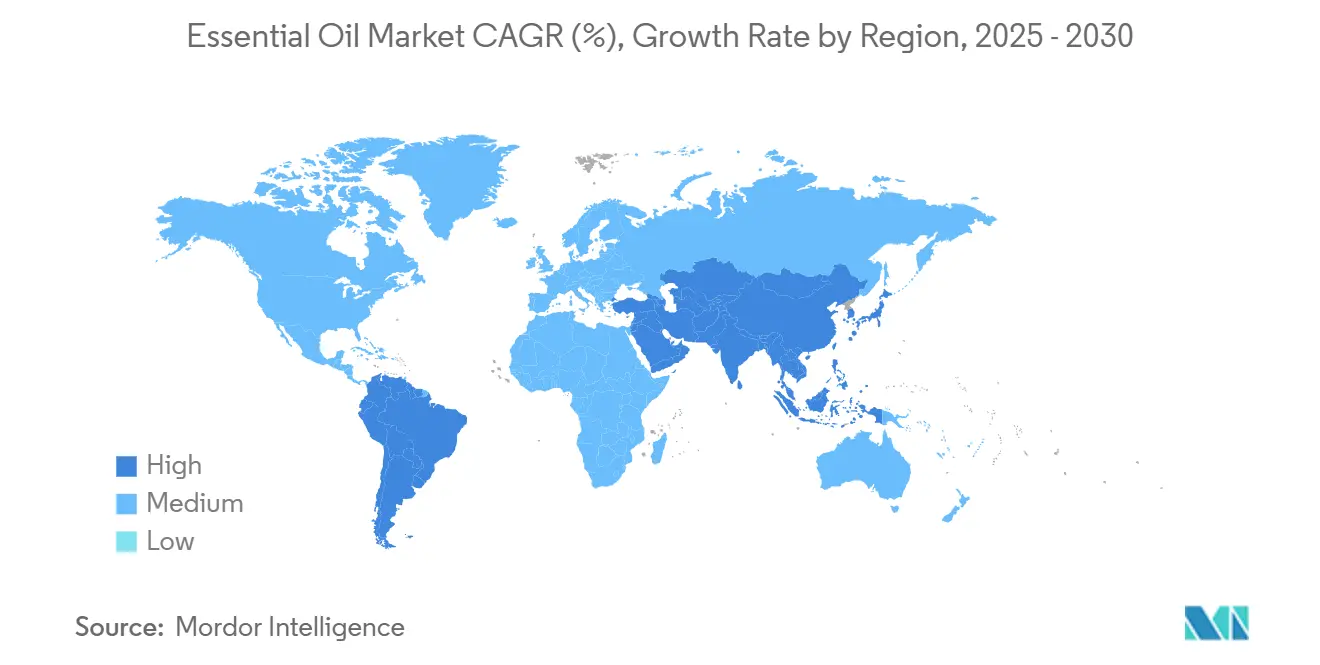
Competitive Landscape
The global essential oil market is fragmented, with a mix of global giants and regional players. Givaudan, Symrise, and DSM-Firmenich integrate farming partnerships, extraction plants, and formulation laboratories to achieve scale efficiencies and accelerate innovation. DSM-Firmenich leverages its expertise in science and innovation to develop sustainable and high-quality natural ingredients, catering to diverse applications across food, fragrance, and nutrition.
Companies like doTERRA and Young Living circumvent traditional retail channels, building customer loyalty through educational communities and generating multibillion-dollar revenues. These organizations secure supply against harvest fluctuations through long-term farmer agreements and cooperative-owned distilleries. Their technological advantages provide competitive barriers: supercritical CO₂ systems reduce energy consumption, while enhanced encapsulation methods improve shelf stability and controlled release in premium products.
Growth potential exists in pharmaceutical-grade oils, where regulatory requirements limit smaller competitors. While biotechnology companies develop fermentation methods for nature-identical compounds, consumer resistance and labeling regulations restrict immediate adoption. Sustainability certifications have become essential requirements, particularly for luxury brands requiring regenerative agriculture verification. Suppliers failing to meet sustainability standards risk losing access to high-margin market segments.
Essential Oil Industry Leaders
-
Biolandes
-
KATO Flavors and Fragrances
-
DSM-Firmenich
-
International Flavors & Fragrances Inc.
-
Givaudan SA
- *Disclaimer: Major Players sorted in no particular order
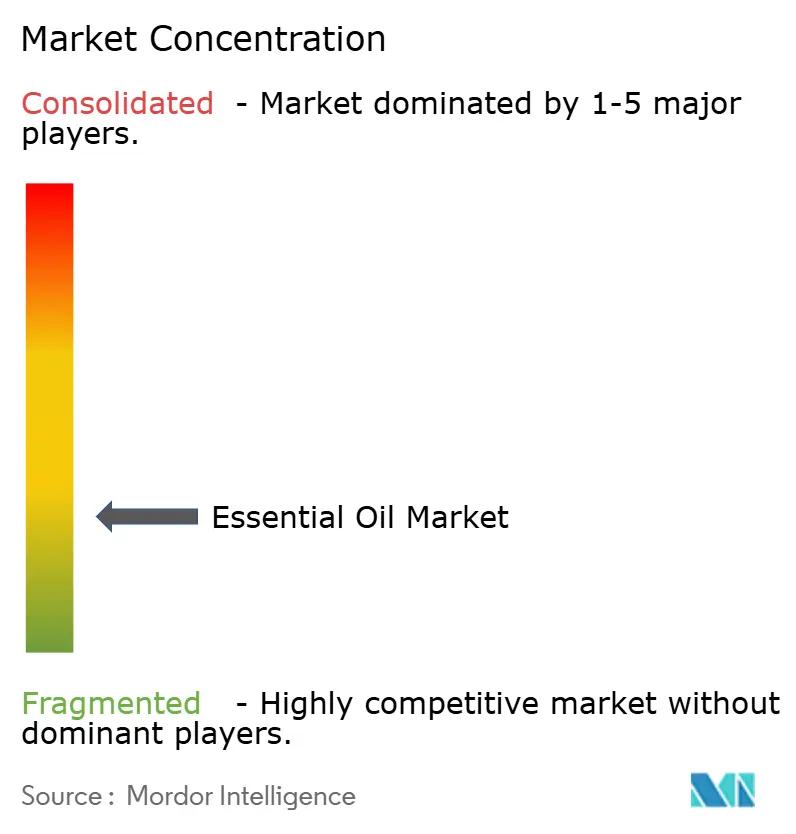
Recent Industry Developments
- April 2025: International Flavors & Fragrances Inc. strengthened its customer service capabilities by consolidating most of its Mexican operations at a new facility in Mexico City's Tecnoparque business complex.
- December 2024: Biolandes strengthened its regulatory compliance and sustainability commitment by establishing an Environmental, Social, and Governance (ESG) team at its Le Sen facility. This initiative demonstrates the company's dedication to maintaining high standards in environmental protection, social responsibility, and corporate governance practices.
- January 2023: VedaOils launched Essential Oil Blends, featuring more than 15 options made from natural fragrances. The blends are suitable for personal use and incorporation into scented products.
Research Methodology Framework and Report Scope
Market Definitions and Key Coverage
Our study defines the essential oils market as the total value of newly extracted, pure or blended, plant-derived volatile oils obtained mainly through mechanical pressing or steam distillation and sold for use in food and beverages, personal care, aromatherapy, pharmaceuticals, perfumery, and household care. Values reflect factory-gate revenues earned by primary oil producers and integrated processors.
Scope Exclusions: synthetic aroma chemicals, by-products such as citrus terpenes, and contract extraction services are outside the study.
Segmentation Overview
- By Type
- Orange Oil
- Cornmint Oil
- Spearmint Oil
- Cedarwood Oil
- Lemon Oil
- Eucalyptus Oil
- Lemongrass Oil
- Clove Oil
- Citronella Oil
- Other Types of Oil
- By Source
- Fruits and Vegetables
- Herbs and Spices
- Flowers
- By Nature
- Conventional
- Organic/Certified Organic
- By Application
- Food and Beverages
- Bakery and Confectionery
- Dairy
- Functional Drinks
- Other Food and Beverages
- Personal Care and Cosmetics
- Pharmaceuticals
- Aromatherapy and Wellness
- Perfumery and Fragrances
- Others
- Food and Beverages
- By Geography
- North America
- United States
- Canada
- Mexico
- Rest of North America
- Europe
- Germany
- United Kingdom
- Italy
- France
- Spain
- Netherlands
- Rest of Europe
- Asia-Pacific
- China
- India
- Japan
- Australia
- South Korea
- Rest of Asia-Pacific
- South America
- Brazil
- Argentina
- Rest of South America
- Middle East and Africa
- South Africa
- Saudi Arabia
- United Arab Emirates
- Rest of Middle East and Africa
- North America
Detailed Research Methodology and Data Validation
Primary Research
Mordor analysts interviewed growers, distillers, ingredient brokers, aromatherapists, and finished-goods formulators across Europe, North America, and Asia-Pacific. These conversations clarified real extraction costs, quality-driven price premiums, and regional demand shifts, letting us validate and refine desk-based assumptions.
Desk Research
We started with trade statistics from UN Comtrade, production data from FAO and USDA, import duty filings from the EU's TARIC, and extraction yield studies published in journals like the Journal of Essential Oil Research. Industry guidance from bodies such as the International Federation of Essential Oils and Aroma Trades and the International Organization for Standardization helped us align product grades. Company 10-Ks, investor decks, and press releases were screened for capacity adds, while price series came from national agricultural boards and D&B Hoovers. Dow Jones Factiva supported historical trend checks. This list is illustrative; many other open sources were consulted for cross-checks and context.
Market-Sizing & Forecasting
A top-down build pairs global orange, mint, and eucalyptus output with average oil yields and export-adjusted apparent consumption, which is then reconciled with sampled supplier revenues and average-selling-price times volume checks. Where data gaps appeared, especially for small botanical oils, country import values were indexed to spot prices to approximate volumes before being balanced against survey feedback. Key variables modeled include citrus processing volumes, organic certified farmland, aromatherapy product launches, cosmetic clean-label claims, and GDP-linked disposable income. A multivariate regression incorporating these indicators generates the 2025-2030 base case, while scenario analysis tests price volatility and regulatory shifts.
Data Validation & Update Cycle
Outputs pass variance thresholds, peer review, and anomaly sweeps. We refresh each dataset annually, with interim updates when material events, such as crop failures or regulatory bans, emerge; a last-mile analyst review precedes report release.
Why Mordor's Essential Oils Baseline Commands Reliability
Published figures often diverge because firms pick different product baskets, pricing anchors, or update cadences. Our disciplined scope, yearly refresh, and dual-source triangulation minimize those gaps.
Key Gap Drivers: Some publishers exclude industrial-grade oils, convert volumes to value using fixed 2022 prices, or age their estimates beyond two years, causing visible spread against our 2025 baseline.
Benchmark comparison
| Market Size | Anonymized source | Primary gap driver |
|---|---|---|
| USD 18.57 B | Mordor Intelligence (2025) | |
| USD 13.66 B (2025) | Global Consultancy A | Narrow product mix and conservative aromatherapy inclusion |
| USD 25.86 B (2024) | Global Consultancy B | Trade-only build, older base year, no quality-tier adjustment |
In sum, our balanced mix of real production metrics, live price curves, and field insight ensures a transparent, traceable baseline that decision-makers can rely on today and recalibrate with ease tomorrow.
Key Questions Answered in the Report
What is the current size of the essential oils market?
The essential oils market is estimated at USD 18.57 billion in 2025 and is projected to reach to USD 28.67 billion by 2030.
Which segment holds the largest essential oils market share?
Citrus oil leads by type with a 24.65% share of revenue in 2024, due to its broad use across food, beverage, and cleaning products.
Why is Europe the leading regional market?
Europe’s 39.19% share stems from strict allergen regulations, consumer preference for natural ingredients, and efficient re-export logistics through Dutch hubs.
What role does technology play in extraction?
Supercritical CO₂ and microwave-assisted processes allows the reduction of oil extraction time and raise yields by more than 60%, improving cost efficiency and purity.
Page last updated on:
